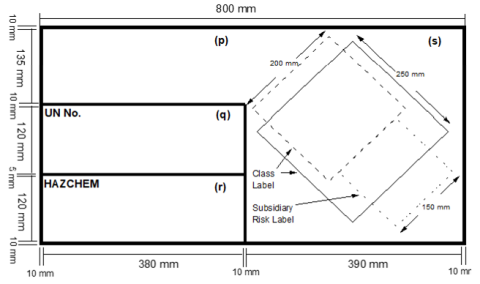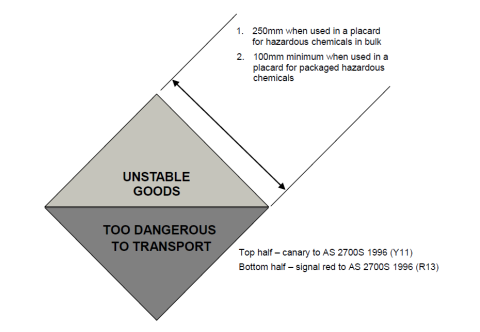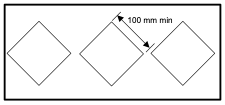Why use safety signs and placards?
Safety signs are required at workplaces that store hazardous chemicals.
Safety signs provide information to workers and visitors about how they can manage risks from hazardous chemicals.
Placards provide information to emergency service workers specific information about hazardous chemicals to assist in the event of an emergency.
Using safety signs for hazardous chemicals
Safety signs are a risk control measure for using, handling, generating and storing hazardous chemicals.
A safety sign has:
-
warnings about hazards
-
information about a particular person’s responsibilities with a hazardous chemical.
You must put the sign next to the hazard, and it must be clearly visible to people approaching the hazard.
Placards for hazardous chemicals
If you store chemicals above the placard threshold quantity specified in Schedule 11 to the model WHS Regulations, you must use placards to provide warnings about the stored hazardous chemicals.
Emergency service workers need this information in case there is an emergency in your workplace.
Placards must be easy to read and current.
There are different placards, including:
-
outer warning placards
-
bulk storage placards
-
placards for goods too dangerous to transport
-
placards for packaged goods
-
placards for flammable liquids category 4 – for example, diesel.
They use the form, dimensions and class labels set by the Australian Dangerous Goods (ADG) Code.
You must not use the Globally Harmonized System (GHS) of Classification and Labelling of Chemicals pictograms for placarding.
Schedule 13 to the model WHS Regulations has information about placarding requirements.
Outer warning placards
Outer warning placards have set dimensions and colours and say the word ‘HAZCHEM’ in red letters on a white or silver background.
The sign is 120 mm high and 600 mm wide. The letters are 100 mm high.
This sign must be located at each entrance to the workplace where emergency services may enter.
You don’t need this placard for fuel classified as flammable gas or flammable liquid sold at refuelling retail outlets, unless you store other types of hazardous chemicals above the placard quantity.
Bulk storage placards
Bulk storage refers to storing a chemical:
-
in a container with a capacity over 500 L or 500 kg
-
in an undivided quantity over 500 kg, if the chemical is a solid.
You need to display bulk storage placards for any of the following chemicals stored in bulk and are classified under the following hazardous chemicals categories under the GHS:
-
Gases under pressure, including Flammable gas – category 1 and 2, and Aerosols – category 1 and 2
-
Flammable liquids - category 1, 2 or 3 Flammable solids - category 1 or 2
-
Self-reactive substances types B to F
-
Self-heating substances category 1 or 2
-
Substance or mixture which, in contact with water, emits flammable gases – category 1, 2 or 3
-
Organic peroxides - type B to F
-
Oxidising solids – category 1, 2 or 3
-
Oxidising liquids - category 1, 2 or 3
-
Acute toxicity - category 1, 2 or 3
-
Skin corrosion - category 1A, 1B or 1C
-
Corrosive to metals - category 1
You do not need this placard for underground storage tanks (USTs) containing fuel classified as a flammable liquid sold at refuelling retail outlets.
Your bulk storage placard must follow a set format, which includes minimum dimensions and specific colours. It must also contain the:
-
proper shipping name
-
UN Number
-
HAZCHEM Code
-
class label and subsidiary risk label specified in the ADG Code.
The specifications of the bulk storage placard that must be met are:
-
lettering must be black on white background and at least 100 mm high. If two lines are used, then it may be 50 mm high
-
the class and subsidiary risk label must be in the form and colouring of the ADG Code and have sides of at least 250 mm.
-
where there is a subsidiary risk, the main class label must have sides of at least 200 mm and the subsidiary risk label(s) must have sides of at least 150 mm. For more than one subsidiary risk, the width of the area on the right-hand side for the subsidiary risk label may be extended.
You must put the placard on or next to each container or storage area.
If you store hazardous chemicals in bulk intended for transport, you must put an ADG Code compliant placard on the container.
Goods Too Dangerous To Be Transported placards
Additional requirements are needed for certain hazardous chemicals that are stored in bulk but are too dangerous to transport. Hazardous chemicals too dangerous to transport are:
-
Unstable explosives
-
Organic peroxides type A
-
Self-reactive substances type A
You must display a Goods Too Dangerous To Be Transport (GTDTBT) placard for these chemicals.
GTDTBT placards have the same format, dimensions and colours as the bulk storage placard, except:
-
the name of the goods given in Appendix A of the ADG code must be shown in the top left area
-
the UN Number and HAZCHEM Code fields must be left blank
-
a label displaying the words ‘Unstable Goods’ and ‘Too dangerous to transport’ shown in the field normally reserved for the class labels and have sides at least less than 250 mm.
Placards for packaged goods and intermediate bulk containers
Packaged hazardous goods are in:
-
containers under 500 L or kg, or
-
intermediate bulk containers (IBC).
If you package a Schedule 11 hazardous chemical (other than Flammable liquids category 4), then you must display a certain type of placard at each entrance to the storage area for the chemicals.
The placard for packaged goods and IBCs must:
-
be of sufficient size to accommodate all class labels required on the placard side by side
-
include all class labels in the form and colouring stated in the ADG Code for the hazardous chemical and with sides no less than 100 mm.
-
have a white or silver background.
You should use the GTDTBT placard for hazardous chemicals that are classified as:
-
unstable explosives
-
organic peroxide type A
-
self-reactive substance type A.
Placarding for flammable liquids category 4 with other flammable liquids
Flammable liquids category 4 chemicals that are also stored with other flammable liquids require an ADG Code compliant Class 3 class label.
Additional requirements for placarding IBCs
IBCs containing Schedule 11 hazardous chemicals stored in the workplace but are not intended for use at the workplace must still have:
-
a placard on the IBC, and
-
a packaged goods placard for the storage area.
Placards for Flammable Liquid Category 4
The GHS classifies Flammable Liquid Category 4 as any flammable liquids with a flash point between 60°C and 93°C.
When stored with other flammable liquids in the same spill compound, a Flammable Liquid Category 4 must have:
-
a class 3 label under the ADG Code
-
the same classification as the flammable liquid with the lowest flashpoint (highest category).
This placard is for any quantity of stored Flammable Liquid Category 4. You must display it on or next to the container or storage area.
It must have:
-
black lettering on a white or silver background
-
letters at least 100 mm high.






